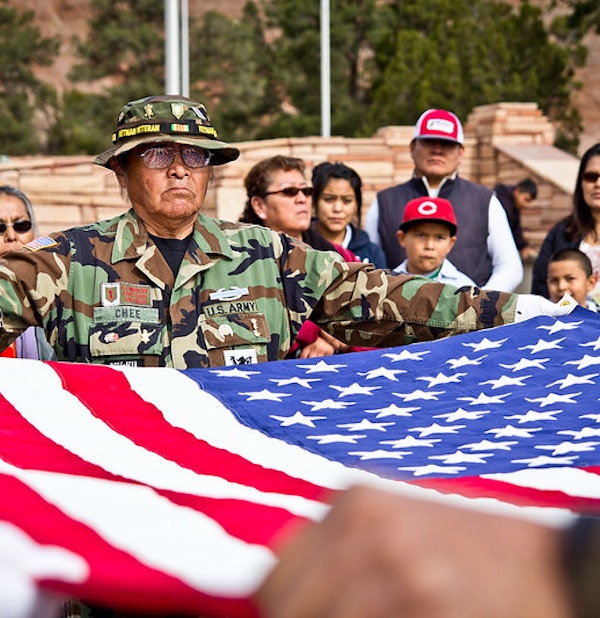We Owe Native American Veterans a Better Health Care System
We are failing in our sacred trust to provide health care for Native American and Alaska Native veterans. But we can restore that trust through greater partnerships, community-based care, telehealth, and engaging Native American and Alaska Native communities.
 Navajo Nation's Veterans Day service in Window Rock, Arizona. (Donovan Shortey/Flickr)
Navajo Nation's Veterans Day service in Window Rock, Arizona. (Donovan Shortey/Flickr)
The story of Native American and Alaska Native veteran health care is akin to all rural veteran health care in the United States: fewer veterans, longer distances, bigger challenges, and scarcer resources. COVID-19 has lifted the veil on the vulnerabilities of our health care system for our Native veterans, but those weaknesses have been known for many years. We are failing in our sacred trust.
Although they are a small percentage of the United States population, there are over 140,000 Native American and Alaska Native veterans in the U.S. Another 24,000 Native American and Alaska Natives serve on active duty in the United States Armed Forces.
Native Americans serve in the military at higher rates than any other demographic. Prior to 9/11, the 2015 American Community Survey reports, Native American and Alaska Natives served at 19.9% per capita versus 13.3% for all other veterans. Post-9/11, Native American women serve at 11.7% of the entire Native American community versus 8.4% for women of all other groups.
Our history of genocide and oppression toward Indigenous citizens has not deterred this group from joining our nation’s military. Native Americans have fought in every major U.S. conflict even though they were not granted citizenship until 1924.
Legacy health issues that plague the Native American communities also impact the veterans of that community. Diabetes, alcoholism, obesity, heart disease, poverty, lack of access to health care, and food insecurity compound an already tenuous health care outlook.
COVID-19 has lifted the veil on the vulnerabilities of our health care system for our Native veterans, but those weaknesses have been known for many years. We are failing in our sacred trust.
According to the 2011 Indian Health Disparities report, the percentage of Native Americans who die of tuberculosis is 500% higher than the rest of the U.S. population. In its 2021 Health Report, USA Today reported Native American men have a life expectancy of 71 years, while white American men live to 78.8 years on average. The conditions that sentence many Native Americans and Alaska Natives to a life of poor health and an early grave manifest themselves in the veteran population as well, particularly in remote and rural areas.
The long distances Native Americans must travel
Geographical dispersion and distance are immense obstacles to care for Native American and Alaska Native veterans across the country. Many tribal communities are located in rural areas. Though there are 574 federally recognized tribes, large tribal nations and communities are located primarily in the Southwestern and Western United States, with vast distances between population centers.
Native American veterans living on reservations outside of the Phoenix metro area have up to a four-hour drive between them and the Phoenix Hayden Veterans’ Administration Medical Center. The story is the same in New Mexico, where the Albuquerque Murphy Veterans’ Administration Medical Center is more than three hours from Shiprock on the Navajo Nation.
The conditions that sentence many Native Americans and Alaska Natives to a life of poor health and an early grave manifest themselves in the veteran population as well, particularly in remote and rural areas.
The Department of Veteran Affairs (VA) has many clinics throughout the U.S. to support its larger mission. Montana, in addition to the Fort Harrison VA Medical Center, has 17 clinics across the state where veterans can get care. New Mexico has 13.
But these clinics usually provide only urgent and outpatient care and pharmacy services. And family and internal medicine doctors staff the clinics. To receive care from a specialist, veterans usually must travel to their state’s main VA Medical Center.
 Indian Health Care Resource Center outside of Tulsa, OK. (Vineyard Perspective/Shutterstock)
Indian Health Care Resource Center outside of Tulsa, OK. (Vineyard Perspective/Shutterstock)
In addition, waits for new patients to see a doctor in non-emergency situations can range from 30-to-65 days, and current patients can wait 30-to-45 days. The best mental health care is found at the state medical center, too far for many veterans in crisis who are suicidal and a danger to themselves and others.
A lack of culturally competent care and an historic mistrust of the health care system also feed into the barriers to effective Native American veteran health care. Native Americans as a community and as individual tribes share traditional healing and medicine practices that are not necessarily recognized or supported in the Western medical system. These practices include but are not limited to sweat lodges, talking circles, storytelling, smudging and purification rituals, and cleansing ceremonies.
And let us not overlook that many Native Americans distrust the health care system due to past tragedies. Those include the forced sterilization of over 3,000 Native American women in the 1970s by the Indian Health Service (IHS). And they include the common systemic experience of individual and cultural discrimination.
Creating better outcomes
With those realities in mind, there are three major areas where continued progress and investment can yield better health care outcomes.
A lack of culturally competent care and an historic mistrust of the health care system also feed into the barriers to effective Native American veteran health care.
The VA can continue its partnership with the Indian Health Service to reach and care for veterans locally in Native American communities. Together, they can reduce barriers to care.
A continued focus on technology and access particularly can create faster and more direct means of care and should be greatly expanded. And investments in training, education, and engagement can improve communication, veteran benefits awareness, and streamline care, especially for patient referrals.
Distance in rural communities will always be a challenge for veterans who are Native Americans and Alaska Natives, but there are ways to alleviate this challenge. For example, the VA, through the Office of Rural Health Programs, has made great progress partnering with the IHS.
As part of their memorandum of understanding, the VA routinely reimburses the Indian Health Service for IHS care of Native American veterans. This creates incentives for culturally competent, community health care for over 7,000 veterans in the IHS system.
In addition, Native veterans in the IHS system can have their prescriptions processed through the VA mail pharmacy system. The latest improvement to care at the VA is the waiver of all copays for Native American and Alaska Native veterans seeking care in the VA system. (Veterans in the IHS system already enjoy that benefit.) This rule is set to go into effect in February after a 30-day public comment period.
Greater investments have been made in telehealth by the VA and should be replicated in tribal communities for veterans. The VA recently opened two telehealth access sites in Montana at Montana State University in Bozeman as well as the University of Montana in Missoula.
The sites serve the veteran student and faculty population at the two schools, including mental health, nutrition, social work, and select primary care counseling. These initiatives are the model for rural health care and greater investments should be made in partnership with IHS to provide them in Native American communities.
Greater telehealth options will allow those seeking mental health care for veteran-specific issues, such as PTSD, to use the VA. They can see doctors who can treat their service-related issues with cultural understanding and patient-related expertise.
Education and engagement are the areas with the most opportunity to improve Native American veteran health care. The VA should have a patient representative in every IHS or tribal hospital to support patient referrals, specialist appointments, and transportation needs. Patients need help and direction at the time of the appointment and should have an obvious resource to turn to while they are still in their hospital or clinic.
More importantly, the VA and IHS need to continue to educate tribal leaders, tribal health care administrative professionals, and tribal Native veteran organizations about veteran health care benefits and how to access them at the organizational and individual level.
The VA can do this across the country through funding created by the PACT Act. That legislation, which passed in 2022, expands VA health care and benefits for veterans exposed to burn pits, Agent Orange, and other toxic substances. The VA should spend extra time hiring and training Native American and Alaska Native outreach specialists to engage Native American veterans directly, not just through tribal leadership, to apprise them of their benefits and educate them on the benefits of joining the VA health care system.
We can do this
The challenges in supporting our Native American and Alaska Native veterans in health care can seem almost insurmountable. Distance, geography, chronic disease, and cultural differences create problems that cause us to fall short as a nation in fulfilling our mandate to our tribal veterans. We must work to solve these problems and deliver what we have promised.
We can fulfill our promise to all our veterans, including our tribal brothers and sisters who stood next to us on the battlefield. We can do that through greater partnership between the VA and IHS, a commitment to community-based care, an investment in innovation through telehealth, and a monumental drive to engage and educate Native American and Alaska Native communities.
We must continue to stand by them, together.
-
Previous Article We Have Solutions for Rural Health Care Essay by Dr. Deborah Birx, Senior Fellow at the Bush Institute
-
Next Article We Need to Explore Psychedelic-Assisted Therapy for Veterans Interview with Margaret Harrell, Chief Program Officer at the Bob Woodruff Foundation, and Colonel Matthew Amidon, Former Director of Veterans and Military Families at the George W. Bush Institute

